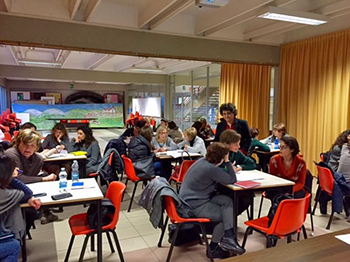Italian Team
Welcome to the Italian team page where we will focus on the ways in which we are developing the autism teacher training materials in our country. Our team is drawn from two organisations: a university (the Università Cattolica del Sacro Cuore and a local education authority (the Ufficio Scolastico Regionale per la Lombardia), both in the region of Milan. This academic and professional partnership is essential in the creation of teacher training programmes which are both of a high standard and accessible to practitioners in educational settings.
 We piloted the Level 1 resources in January 2016 and were able to gather together a large group – 98 people in total – of teachers and teaching assistants from three mainstream schools in the district of Monza, to the north of Milan. We were delighted that we were able to test the materials with such a large number of education professionals who work with autistic children between the ages of five and ten. The following month, in February, we piloted the Level 2 materials. While the Level 1 had consisted of a single session of two and a half hours, the Level 2 involved activities which were more in depth, and so required four separate sessions, of ten hours training in total.
We piloted the Level 1 resources in January 2016 and were able to gather together a large group – 98 people in total – of teachers and teaching assistants from three mainstream schools in the district of Monza, to the north of Milan. We were delighted that we were able to test the materials with such a large number of education professionals who work with autistic children between the ages of five and ten. The following month, in February, we piloted the Level 2 materials. While the Level 1 had consisted of a single session of two and a half hours, the Level 2 involved activities which were more in depth, and so required four separate sessions, of ten hours training in total.
While we are using the Autism Education Trust (AET) materials as our basis for developing the Italian teacher training programmes, it has been important to adapt these to the pedagogical and practical needs of our own country. This also impacts on our approach to delivering the training, where there is greater emphasis on interaction and discussion than perhaps is the case in the UK. Indeed, the feedback from the Level 2 pilot sessions showed that the ‘time to talk’ sessions were found to be of the greatest use for trainees. Participants stated that this time was very important to share knowledge, experience and awareness of the autistic children in their classes.
One participant said:
 |
I found it very interesting, motivating and precious to learn, with my colleagues what we can do as a team for A., our autistic pupil. I think every teacher should attend training like this: now we know what we can do better for him!
|
Italian terminology
Italian Translation
Benvenuti nella pagina del team italiano dove sono descritte le modalità in cui stiamo sviluppando i materiali di formazione per insegnanti della scuola primaria che accolgono alunni autismo nel nostro Paese. Il nostro team è composto da due organizzazioni: un’università ed ente di ricerca (Università Cattolica del Sacro Cuore – Centro Studi e Ricerche sulla Disabilità e Marginalità) e ente scolastico provinciale (Ufficio Scolastico Regionale per la Lombardia – sezione di Monza e Brianza). Questa partnership accademica e professionale è essenziale per la creazione di progetti di formazione per insegnanti, che sono sia di alto livello che accessibili ai docenti ed educatori di ciascun educativi scolastico.
Abbiamo sperimentato il Livello 1 a gennaio 2016 e siamo stati in grado di attivare un grande gruppo di insegnanti e assistenti - 98 persone in totale - provenienti da tre scuole primarie di Lissone, città in provincia di Monza. Siamo soddisfatti di essere stati in grado di provare i materiali con un ampio numero di professionisti che lavorano con i bambini con autismo di età compresa tra sei e dieci anni. Il mese successivo, nel mese di febbraio, abbiamo sperimentato il secondo livello formativo. Mentre il livello 1 consisteva di una singola sessione di due ore e mezza, il livello 2 approfondisce maggiormente i temi ed è quindi necessario realizzarlo in quattro sessioni separate, per un totale di 10 ore.
E’ stato molto utile e prezioso poter utilizzare i materiali forniti dall’Autism Education Trust (AET) come base per lo sviluppo dei programmi di formazione da noi sperimentati, è stato importante adattare i materiali inglesi secondo i modelli pedagogici ed inclusivi del nostro Paese. Ciò influisce anche sul nostro approccio di fare formazione, in cui vi è una maggiore enfasi sull’interazione e sulla discussione tra partecipanti e formatore. In particolare, il feedback dalle sessioni sperimentali del livello 2 hanno mostrato che il tempo dedicato al confronto è risultato essere quello di maggiore utilità per i partecipanti.